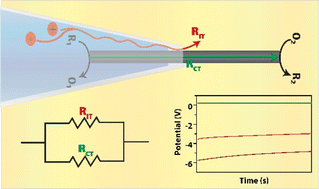On the mechanism of the bipolar reference electrode†
Abstract
Commercial silver/silver chloride (Ag/AgCl) reference electrodes are some of the most commonly used reference electrodes, but they suffer from a number of issues due to their porous frits. Such issues include difficulty miniaturizing, silver and chloride ion leakage, charge screening effects at low ionic strength, frit drying if left unattended in air, and incompatibility with organic solvents. To solve these issues, we recently designed a reference electrode that is leakless in principle by replacing the porous frit with a sealed, conductive wire, where the ends of the wire are exposed to the reference electrode solution and the working electrode solution. We hypothesized that the reference electrode operated like a closed, bipolar electrochemical cell, and we termed the name bipolar reference electrode (BPRE). Here, we provide evidence that the BPRE can either act as a reference electrode by operating through an ion transfer mechanism via leakage through the imperfect seal, or it can act as a highly stable quasi-reference electrode through a bipolar electron transfer mechanism (BPQRE). Finally, we demonstrate the effectiveness of the BPRE in other types of common electrochemical studies, including chronoamperometry, linear sweep voltammetry, differential pulse voltammetry, and electrochemical impedance spectroscopy.



 Please wait while we load your content...
Please wait while we load your content...